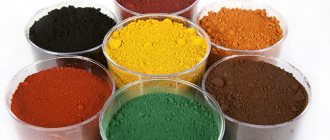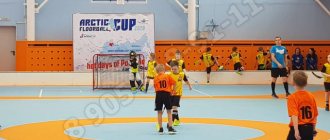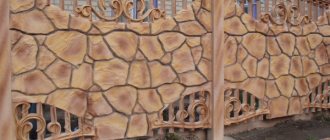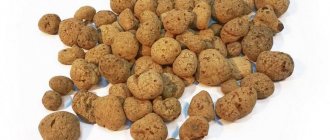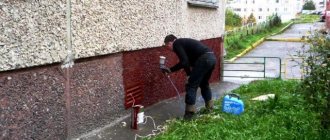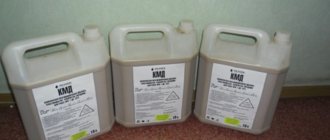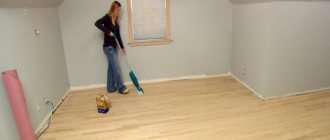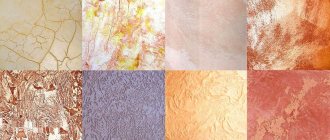Why paint concrete
There can be many reasons why people resort to painting concrete surfaces:
- decorative colors;
- advertising picture;
- giving the surface an anti-slip effect;
- antistatic properties;
- road markings;
- increased chemical resistance;
- the need for painting the floors of food-related industries;
- apply a coating to obtain a dust removal effect;
- giving surfaces waterproofing properties;
- Using painting you can level concrete surfaces.
To give concrete surfaces a stable, non-erasable white color, it is best to use white cement for molding products.
To obtain a black color, you will need to add pigment to the concrete mixture - what does this mean?
When mixing in a concrete mixer, pigment is added to the solution and mixed thoroughly. The consumption will depend on the density of the tone you want to achieve.
You must understand that such surface painting will be expensive.
Types of pigments and release form
Acid dyes
This is an amazing material that recently appeared on the construction market and created a sensation.
The paint enters into a chemical reaction with the elements of cement stone and forms the necessary color scheme on the surface. This reaction allows the desired color to remain for a long time and is erased only from the surface layer.
The top layers of concrete are etched and the resulting insoluble deposits give the required color to the surface. This dye can be applied not only to fresh surfaces, but also to those that have been exposed to precipitation for many years, i.e. on old concrete.
This operation will revive and create incredibly beautiful tones. This technology is mainly used for floors and paving.
The dye application technology has a number of features. Before starting painting, it is necessary to make a sample on the concrete surface and select the desired tone.
The dye consumption can vary and depends on the porosity and texture, the number of layers applied and the age of the concrete.
Old surfaces will require more dye and possibly more than one coat.
Approximate consumption is 1 liter per 3-5 m2 of floor area.
When applying an acid dye, it should hiss, this is a sign of a reaction. If this does not happen, then the surface is not ready to react. It needs to be treated with a weak solution of acetic acid.
The application of the dye to the surface should be accompanied by simultaneous rubbing of it into the concrete in a circular motion. Rubbing is carried out until the solution sizzles.
The process of applying the dye should be uniform and thin-layered, avoid the formation of puddles on the surface, and immediately rub them with a brush. This job requires skill and caution.
This technology can be used to paint not only vertical surfaces, but also horizontal ones. Only the dyeing process begins from the bottom and layer by layer rises to the top.
Do not allow excessive dye “drip” to form.
The original shade will only be obtained after 4 hours, because a chemical reaction of the hydration products of the cement with the dye will occur.
When preparing the dye, it must be diluted in the appropriate concentration; if the concentration changes, the shade will change. Moreover, even if the cement content in concrete changes, you can get a different shade.
Here, for example, are the colors offered by one of the companies, to understand what the color range might be.
| Name | Concrete shade |
| Oak bark (EA) | Dark brown |
| Ebony (HD) | Black/cafe with milk |
| Laguna (TR) | Blue |
| Tobacco (AA) | Red-brown |
| Ryzhik (DH) | Brown-red |
| Sun (AM) | Yellow |
| Amber (SP) | Amber brown |
Acrylic dyes
Acrylic paints are used mainly as water-dispersion paints, i.e. They are diluted with water and do not contain substances harmful to humans.
Their chemical composition contains polymers of esters of acrylic, methacrylic or cyanoacrylic acids. But more simply, it is pigment, water and acrylic resin.
Dries quickly and is no longer washed away by water. There are versions for external and internal use, because they are not afraid of the sun, water and temperature fluctuations.
Another advantage of these paints is vapor permeability, which allows you to paint bathrooms without fear that condensation will form under the paint layer.
But, as with any other paints, when working with acrylic it is necessary to prime the concrete surfaces before starting painting. These paints are very popular for facade surfaces.
Epoxy paint
The very name of these paints suggests that they are prepared on the basis of epoxy resins. These paints appeared in the middle of the last century. Epoxy enamels are very popular in construction.
They consist of epoxy resins, hardeners, pigments, modifiers, solvents and diluents with additives.
Such a complex structure makes it possible to obtain dyes that can withstand heavy loads when painting concrete floors. These are the best paints for shopping centers, automobile workshops, industrial buildings, food blocks of educational premises, and airplane hangars.
Usually the paint is two-component and it is necessary to strictly follow the proportions according to the instructions to obtain durable coatings, but there are also powder and aerosol options.
These compounds come in hot and cold curing, depending on the temperature and type of hardener. But cold is more often used, which is more practical.
For concrete floors, two-component and water-dispersed ones are usually used. Depending on how different properties are imparted to paints, appropriate additives are added to them.
For example, phenolic resins are added to protect against chemical reagents; for wear resistance, quartz sand and glass dust are added to mechanical abrasions.
Concrete surfaces painted with epoxy, two-component paints are purchased additionally:
- waterproofing properties;
- abrasive resistance;
- elasticity;
- vapor permeability;
- electrostatic properties;
- biocidal additives improve the ability to resist the occurrence of fungi and bacteria;
- easy to clean with any means;
- Craftsmen can paint it themselves.
Powder dye
This painting method is not so often used for painting concrete surfaces, but it is possible when preparing paving slabs or decorative elements made of natural stone.
They are solid dispersed compositions consisting of resins, hardeners, pigments and various modifying additives.
The powder is applied to the surface with a sprayer and then the object is fed into the oven, where baking occurs at a temperature and a very hard polymer layer is formed.
Surfaces painted in this way have:
- increased impact resistance;
- high adhesion (adhesion of powders to the concrete surface);
- high resistance to acids, alkalis, solvents, etc.;
- very wide temperature range, which can be from -60 to +150;
- wide color palette;
- dries quickly;
- Almost 100% of all material is used.
Rubber paint
This paint has recently appeared in construction. It looks like mastic, and after application and drying it turns into a rubber film.
It is based on acrylate latex, pigments and necessary additives. The elasticity of this material determines the areas of application.
Possessing waterproofing properties, it is widely used in painting swimming pools and adjacent concrete surfaces, marking road surfaces, and tennis courts. It has proven itself well when carrying out repair work, roofs, for example.
Simple dyes
Used at home. It is enough to select the powder according to the required color in any hardware store and you can dilute it yourself at home with water or solvent and paint the paths or concrete terrace.
Characteristics
The production of coloring and pigmenting agents is a complex technological process. As a result, paints have some technical characteristics. Craftsmen, as a rule, rarely delve into the intricacies of production, however, some parameters should be taken into account when purchasing a particular brand of color.
Useful to know > Artline brand epoxy resin from a domestic manufacturer
The list of characteristics cannot be called universal, since each manufacturer indicates its own list of parameters. You can list what exactly the buyer will find on the packaging or in the instructions.
- Material. Dyes do not have a strictly defined chemical formula. In fact, these can be a variety of substances. The main thing is that they do not react with the main composition of the epoxy resin. For example, there are dyes based on propylene. Pigment powders are made from mica, and some pre-made additives are already made as the "A" component of epoxy resin.
- Type. Everything is very simple here: the paint is presented in the form of a liquid, paste or powder. The buyer must determine for himself which consistency is more convenient for him to work with. The fact is that professional artists “play” with shades. Naturally, this is achieved by dispensing paint. But if, for example, adding powder does not affect the curing process in any way, then when adding a liquid component, the proportion will be disrupted and additional adjustments will be required.
- Color. In principle, the buyer can evaluate the shade visually, but after mixing the dye with the resin, the result may change. Many skeptics argue that the shade will change, but not the color itself. But it is enough to recall a number of cases when black paint was purchased, but in reality it turned out to be dark blue or brown. Modern manufacturers provide a huge selection of colors, and each of them can be combined with a phosphor.
- Weight/Volume/Dimensions. All these parameters indicate the amount of dye in the package. Before going to the store, the buyer must calculate how much material will be needed to implement his plan. Next, he purchases resin, hardener and dye in such quantities as to minimize costs.
- Effect. The manufacturer often indicates additional properties of the color. Examples include whitening, pearlescent, ultraviolet glow, glow in the dark and finally no effect.
Colored additives in concrete
If you add a pigment to the concrete mixture during its preparation, which will be either in the form of a powder or in a suspension form, then the output will be colored concrete.
Color additives should not exceed 5% of the batch weight, otherwise the strength characteristics of concrete can be reduced.
Products made from such concrete will never lose their color attractiveness; there is no need to repaint them.
Application of acid dye
The concentration of the tint composition on the plane depends not only on the proportion of the pigment, but also on the method of applying the mixture. When working, a plastic spray gun is used, from which a solution is sprayed under pressure. The power tool must be suitable for working with acidic compounds. To achieve a rich, thick shade, paint is applied with a brush. After it, traces of strokes remain noticeable, so you need to go over the surface being treated again using a pump sprayer until they completely disappear.
To achieve the “marble” effect, the concrete slab is placed at a slight slope and paint is liberally applied. As a result, self-distributed acid dyes for concrete form an irregular pattern, imitating an expensive material. To form a natural pattern with veins, two mixtures are used:
- strong concentration - a rich, bright color is obtained;
- weak concentration - a light, bleached shade is obtained.
First, apply dark paint, then, without waiting for it to dry, apply a light mixture in thin streams. When it begins to spread on its own, simple patterns are obtained in the form of visible veins of concentrated dark paint. A multi-colored coating is obtained as a result of alternating and applying compositions of different shades.
Popular brands of paints for concrete surfaces
Which paint to use depends on the conditions in which the concrete structure will be located.
Yaroslavl paints, which have a full line of acrylic and epoxy enamels for working on concrete, have proven themselves to be excellent.
There is an interesting paint for washing off efflorescence formed during cement hydration, when a reaction occurs and a white coating appears on the surface.
This efflorescence is called slaked lime (CaO + H2O Ca(OH)2). Below are several types of facade paints popular in Russia.
| Trademark | Consumption per layer sq. meters, ml | Duration of operation, years | Place of production | Cost in rubles |
| Yaroslavl paints | 150 | up to 5 | Russian Federation | 160−220 |
| Wood plastic | 300 | 3 | Russian Federation | 200 |
| Aquatex Extra | 150−200 | 5 | Russian Federation | 200−250 |
| Pinotex ultra | 150 | 3−5 | Estonia | 350−410 |
| Belinka Toplasur | 150 | 5 | Slovenia | 350−450 |
| Teknos AQUATOP 2920 or Teknal 2460 | 170 | 4 | Finland | from 500 |
Popular makes and models
Let us note once again that the market for accessories for working with epoxy resin is rapidly expanding with new players. Such an increase in production became possible thanks to the development of advanced technologies. Compact factories for the production of resins and dyes have recently begun to appear like mushrooms after rain. It is not surprising that some brands have not yet gained traction. However, we will try to give some of the most striking examples.
Poly Max Dream
The dyes, known under the Poly Max Dream brand, are sold as a kit consisting of five components:
- white;
- blue;
- green;
- red (fluorescent);
- pink.
The price of one set is 1000 rubles. The weight of each component is 15 g. The manufacturer also offers individual colors in 50 g containers, as well as set No. 2, in which white and pink are replaced by purple and orange. The products are mainly used to imitate ruby and emerald stones. The color is environmentally friendly and does not harm human health.
MG Epox Color M
The liquid dye is sold in bottles of 10 g. The cost of one bottle is 125 rubles. The manufacturer produces colors in white, yellow, green, brown, red, orange, purple, blue and black. There are also pearlescent shades: red, bronze, copper, gold, pearls. The metallic pigment is available in only one shade – silver. All dyes are compatible with each other and can be mixed. The recommended percentage of the dye volume is 1-2% percent of the epoxy resin volume.
Crystal
Under this brand you can find a huge variety of accessories for drawing and applied arts. The paints in question are presented by the store and the company of the same name, Hobby magic. You can order the color only through the online store. The buyer can choose from a range of transparent and pearlescent paints. Each color has its own code. The collection consists of 50 different shades. The material is packaged in 10 and 30 grams. The cost of a ten-gram portion is 115 rubles. For 30 g of paint you will have to pay 295 rubles.
Useful to know > Which epoxy resin is perfect for creativity, features of choice
Polymer-O (Palizh)
Paste colors are highly concentrated. The cost of a package weighing 50 grams is 500 rubles. In addition to conventional dyes, pastes contain a phosphor and a fluorescent substance. The manufacturer also offers pigmented pearlescent pastes of various shades. For filling large areas, the color is sold in 1.6 kg tins.
Epoxicon
Epoxicon dyes differ from their analogues in that they are diluted with a high concentration in the main component of epoxy resin. Stamps with pearlescent pigment contain natural mica filling. The material is resistant to ultraviolet radiation and high temperatures. You can work with the dye without protective equipment, as it is absolutely safe. 10 grams of dye costs 120 rubles.
ArtLine
A well-known brand that has gained popularity thanks to the production and sale of epoxy resins is represented by a dye of the same name. ArtLine dyes are a homogeneous liquid that mixes well with epoxy resin. The material is packaged in glass flasks of 5 ml. The price of one flask is 160 rubles. Available in red, green, yellow, purple and blue.
EpoximaxX
EpoximaxX is another well-known manufacturer of jewelry resins and accessories. EpoximaxX dyes are highly concentrated. The maximum permissible share of filler is 5%. The paste is harmless and odorless. At the same time, it mixes well with the resin components, forming a homogeneous mass. The pastes form a transparent and matte composition. Both types of dye are available in different shades.
Reactint
These dyes can be called innovative. They are designed not only for epoxy resins, but also for painting plastic or polyurethane. The filler is in a liquid state, but it is highly concentrated. The maximum color content should not exceed 0.1% by weight of the epoxy, otherwise there is a high probability that the paint will influence the polymerization process. For 15 grams of Reactint paint you will have to pay 350 rubles.
MICA Rainbow UV
You cannot ignore goods from China. On the Aliexpress website you can order pigment powder for epoxy resin of almost any shade. It is made of natural mica and does not in any way affect the process of polymer formation. The cost of such powders does not exceed 50 rubles per package.
Features of DIY cooking
If you decide to prepare colored concrete yourself for, for example, paving slabs, then you need to pay attention to the following points:
- mix the dry pigment initially with sand in a concrete mixer;
- while stirring, add cement to them;
- After obtaining a homogeneous composition, add the required amount of water.
As previously mentioned, the pigment by weight should be about 5%.
This video will tell you in detail and show you how to do it right yourself.
Briefly about the main thing
- When purchasing paints in a store, always check whether they are for exterior or interior use.
- When diluting water-emulsion paints, do not add more than 10% water.
- In Russia, acrylic paints are designated VD - AK - index.
- When preparing colors or concrete mixtures yourself, do not skimp on mixing time.
- If you are painting old concrete, carefully prepare the surface, remove grease stains with a solvent, and remove old paint, if possible.
- The Yaroslavl Spetsnaz remover adequately combats slaked lime efflorescence on concrete surfaces.
- Before applying the main layers of paint to the surface, do not forget to prime it first, preferably with those primers that are intended for this type of paint.
- If the technology requires 2 or more layers of paint, be sure to let each layer dry for at least a day.
- Protect your eyes from contact with any paints; wear safety glasses.
- Follow the instructions for storing paints.
- After work, do not forget to tidy up the tool.
